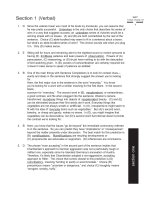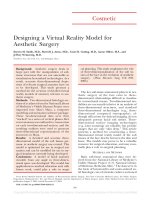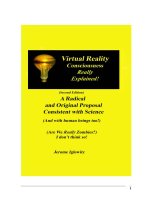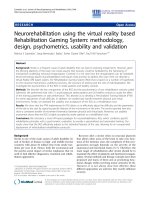Unity Virtual Reality Projects
Bạn đang xem bản rút gọn của tài liệu. Xem và tải ngay bản đầy đủ của tài liệu tại đây (5.34 MB, 286 trang )
[1]
www.it-ebooks.info
Unity Virtual Reality Projects
Explore the world of virtual reality by building immersive
and fun VR projects using Unity 3D
Jonathan Linowes
BIRMINGHAM - MUMBAI
www.it-ebooks.info
Unity Virtual Reality Projects
Copyright © 2015 Packt Publishing
All rights reserved. No part of this book may be reproduced, stored in a retrieval
system, or transmitted in any form or by any means, without the prior written
permission of the publisher, except in the case of brief quotations embedded in
critical articles or reviews.
Every effort has been made in the preparation of this book to ensure the accuracy
of the information presented. However, the information contained in this book is
sold without warranty, either express or implied. Neither the author, nor Packt
Publishing, and its dealers and distributors will be held liable for any damages
caused or alleged to be caused directly or indirectly by this book.
Packt Publishing has endeavored to provide trademark information about all of the
companies and products mentioned in this book by the appropriate use of capitals.
However, Packt Publishing cannot guarantee the accuracy of this information.
First published: August 2015
Production reference: 1280815
Published by Packt Publishing Ltd.
Livery Place
35 Livery Street
Birmingham B3 2PB, UK.
ISBN 978-1-78398-855-6
www.packtpub.com
www.it-ebooks.info
Credits
Author
Project Coordinator
Jonathan Linowes
Sanjeet Rao
Reviewers
Proofreader
Krystian Babilinski
Safis Editing
Arindam Ashim Bose
Indexer
Rongkai Guo
Priya Sane
Arun Kulshreshth
Robin de Lange
Production Coordinator
Samuel Mosley
Shantanu N. Zagade
Commissioning Editor
Neil Alexander
Cover Work
Shantanu N. Zagade
Acquisition Editor
Reshma Raman
Content Development Editor
Mamata Walkar
Technical Editor
Gaurav Suri
Copy Editor
Vedangi Narvekar
www.it-ebooks.info
About the Author
Jonathan Linowes is the owner of Parkerhill Reality Labs, a start-up VR/AR
consultancy firm. He is a veritable VR and 3D graphics enthusiast, full-stack web
developer, software engineer, successful entrepreneur, and teacher. He has a fine arts
degree from Syracuse University and a master's degree from the MIT Media Lab. He
has founded several successful start-ups and held technical leadership positions at
major corporations, including Autodesk Inc.
This book is dedicated to Lisa—my wife, best friend, and soul
mate—and the amazing family we created together: Rayna, Jarrett,
Steven, and Shira who know in their hearts that the future is theirs
to embrace.
www.it-ebooks.info
About the Reviewers
Krystian Babilinski began working with Unity and Blender when he was in
middle school. Since high school, he and his brother, Adrian, taught via Google's
Helpouts service. Through teaching, he exposed himself to a new assortment
of problem sets, which he then experienced firsthand. Slowly, he began getting
involved in large-scale projects and freelance work. With a growing portfolio and
knowledge of Unity 3D along with platform optimizations, he and his brother started
their own creative firm in 2014. They began developing assets for Unity's Asset Store
and worked for larger clients, such as The Hasley Group and Beach Consulting.
These successes wouldn't have been possible without their loyal customers.
Arindam Ashim Bose, as of 2015, is pursuing his master's degree in computer
science at the Georgia Institute of Technology in Atlanta. He is interested in
computer graphics, virtual and augmented reality, and game development.
He was born in Mumbai and has been fascinated by computers and technology,
especially computer games, since a very young age. He would spend countless
hours during his vacations and weekends playing games and tinkering with them
to modify them. It was this habit of tinkering and modding that got him into
computer programming.
He is currently trying to break into the games industry as a programmer while
pursing his master's degree.
www.it-ebooks.info
Rongkai Guo is an assistant professor in the department of computer software
engineering and game design and development at Kennesaw State University. His
research interests are serious gaming, computer/mobile gaming, and virtual reality
(VR). He has been conducting research on a VR for rehabilitation project for more
than 4 years. He has conducted his first basic research study, IN THE WORLD,
which formally investigated how VR impacts persons with mobility impairments.
Arun Kulshreshth is a researcher in the department of computer science at the
University of Central Florida. His research interests include 3D user interfaces,
human-computer interactions (HCI), games, and virtual reality. He received his
master of technology (an integrated 5-year program) in mathematics and computing
from the Indian Institute of Technology, Delhi, in 2005. He received a master of
science in computer science in 2012 and a PhD in computer science in 2015 from
the University of Central Florida.
He is the author of several publications that are related to his research work
pertaining to utilizing 3D user interface technologies (such as stereoscopic 3D,
head tracking, gestural interfaces, and so on) for video games. He is a professional
member of the Association for Computing Machinery (ACM) and Institute of
Electrical and Electronics Engineers (IEEE). In the past, he has conducted research
at several international locations, including Spain, Denmark, and USA. One of his
papers was awarded an honorable-mention award in a leading HCI conference
(CHI 2014). In 2014, his name was featured in a Reuters article, and one of his
projects was featured on Discovery News.
www.it-ebooks.info
Robin de Lange is a researcher, lecturer, and entrepreneur with a focus on virtual
reality and education.
Robin has an MSc degree in media technology from Leiden University and
a bachelor's degree in physics and philosophy from the same university. He
conducts part-time PhD research at the media technology research group of Leiden
University under the supervision of Dr. Bas Haring. For his research, he is exploring
the potential of augmented and virtual reality to understand and solve complex
problems. Part of this research is an elective course, where Robin leads a group of
students to create virtual reality prototypes for the field of education.
Besides his academic career, Robin has started many different initiatives. He is the
director of a homework guidance company and the founder of Lyceo CodeWeken, a
unique program for high-school students that teaches how to code.
Samuel Mosley is a game designer. He studied programming and game design
at the University of Texas in Dallas. Showing an interest in both programming and
games, he hopes to play an important role in both fields. He is currently working
as a game designer for Bohemia Interactive Simulations.
www.it-ebooks.info
www.PacktPub.com
Support files, eBooks, discount offers, and more
For support files and downloads related to your book, please visit www.PacktPub.com.
Did you know that Packt offers eBook versions of every book published, with PDF
and ePub files available? You can upgrade to the eBook version at www.PacktPub.
com and as a print book customer, you are entitled to a discount on the eBook copy.
Get in touch with us at for more details.
At www.PacktPub.com, you can also read a collection of free technical articles, sign
up for a range of free newsletters and receive exclusive discounts and offers on Packt
books and eBooks.
TM
/>
Do you need instant solutions to your IT questions? PacktLib is Packt's online digital
book library. Here, you can search, access, and read Packt's entire library of books.
Why subscribe?
• Fully searchable across every book published by Packt
• Copy and paste, print, and bookmark content
• On demand and accessible via a web browser
Free access for Packt account holders
If you have an account with Packt at www.PacktPub.com, you can use this to access
PacktLib today and view 9 entirely free books. Simply use your login credentials for
immediate access.
www.it-ebooks.info
Table of Contents
Prefacevii
Chapter 1: Virtually Everything for Everyone
1
What is virtual reality to you?
2
Types of head-mounted displays
4
Desktop VR
4
Mobile VR
5
The difference between virtual reality and augmented reality
5
Applications versus games
6
What this book covers
9
Who are you?
9
Types of VR experiences
10
Technical skills that are important to VR
11
Summary12
Chapter 2: Objects and Scale
Getting started with Unity
Starting a new Unity project
The Unity editor
The default world space
Creating a simple diorama
Adding a cube
Adding a plane
Adding a sphere and some material
Changing the scene view
Adding a photo
Coloring the ground plane
[i]
www.it-ebooks.info
13
14
14
15
16
17
17
18
20
22
23
25
Table of Contents
Measurement tools
25
Keeping a unit cube handy
26
Using a Grid Projector
26
Measuring the Ethan character
29
Importing from the Blender experiment
30
An introduction to Blender
31
A unit cube
34
A UV Texture image
35
Importing into Unity
38
A few observations
39
Summary40
Chapter 3: VR Build and Run
41
Chapter 4: Gaze-based Control
59
VR device integration software
42
Unity's built-in VR support
42
The device-specific SDK
42
The OSVR project
43
WebVR43
3D worlds
44
Creating the MeMyselfEye prefab
44
Build for the Oculus Rift
45
Build for Google Cardboard
46
The Android setup
47
The iOS setup
47
Installing the Cardboard Unity package
47
Adding the camera
48
The build settings
48
The Play Mode
49
Building and running in Android
49
Building and running in iOS
50
The device-independent clicker
50
How virtual reality really works
52
Stereoscopic 3D viewing
52
Head tracking
56
Summary58
Ethan, the walker
Artificially intelligent Ethan
The Navmesh bakery
A random walker in the town
Interlude – a quick introduction to Unity programming
[ ii ]
www.it-ebooks.info
60
61
62
63
63
Table of Contents
The RandomPosition script
66
"Zombie-ize" Ethan!
68
Go where I'm looking
69
The LookMoveTo script
70
Adding a feedback cursor
72
Observations73
If looks could kill
74
The KillTarget script
74
Adding particle effects
77
Cleaning up
79
Summary79
Chapter 5: World Space UI
81
A reusable default canvas
83
The visor HUD
87
The reticle cursor
89
The windshield HUD
91
The game element UI
93
The info bubble
96
An in-game dashboard with input events
99
Creating a dashboard with buttons
100
Linking the water hose to the buttons
103
Activating buttons from the script
104
Look to highlight a button
106
Looking and then clicking to select
108
Looking and staring to select
109
A responsive object UI with head gestures
111
Using the head position
111
Using head gestures
113
Summary117
Chapter 6: First-person Character
119
The Camera component
The Rigidbody component
The Character Controller component
120
121
121
Understanding the Unity characters
Unity components
Unity Standard Assets
120
120
122
ThirdPersonController123
AIThirdPersonController124
FirstPersonController124
RigidBodyFPSController124
[ iii ]
www.it-ebooks.info
Table of Contents
Making a first person
125
Move in the direction you're looking
126
Keep your feet on the ground
127
Don't pass through solid objects
127
Don't fall off the edge of the world
129
Stepping over small objects and handling uneven terrain
130
Start and stop moving
130
Using head gestures to start/stop
131
User calibrations
132
A character's height
132
Real-life height of a player
135
Recentering136
Maintaining a sense of self
136
Head-body disconnect
136
Head and body...
137
...And feet
138
The body avatar
140
Virtual David le nose
141
Audio cues
143
Locomotion, teleportation, and sensors
144
Managing VR motion sickness
146
Summary148
Chapter 7: Physics and the Environment
149
Unity physics
150
Bouncy balls
152
Headshots156
Trampoline and brick
160
A human trampoline
162
Like a brick
162
Like a character
163
Interlude – environment and things
167
Wispy Sky
167
The planet Earth
167
The corporate logo
168
Blender168
Unity169
An elevator
170
Jumping171
Summary173
[ iv ]
www.it-ebooks.info
Table of Contents
Chapter 8: Walk-throughs and Rendering
175
Simplify your models
Using texture maps instead of complex meshes
Limiting the objects to be drawn
Lighting and shadow performance
Optimizing your scripts
198
198
199
199
200
Building in Blender
176
Walls176
Ceiling181
Assemble the scene in Unity
184
The gallery room
184
The artwork rig
185
The exhibition plan
188
Adding photos to the gallery
190
An animated walk-through
193
Unity's animation system
193
Scripted animation
194
Optimizing for performance and comfort
196
Optimizing your implementation and content
198
Optimizing for the Unity rendering pipeline
Life's a batch
Multipass pixel filling
Other rendering tips
200
200
202
203
Optimizing for the target hardware and drivers
203
Unity Profiler
204
Summary206
Chapter 9: Using All 360 Degrees
207
360-degree media
208
Crystal balls
209
Magic orbs
210
Panoramas214
Infographics215
Equirectangular projections
218
Globes220
Photospheres222
Field of view – FOV
225
Capturing a 360-degree media
227
Summary228
[v]
www.it-ebooks.info
Table of Contents
Chapter 10: Social VR Metaverse
229
Multiplayer networking
230
Networking services
230
The network architecture
231
Local versus server
232
The Unity networking system
234
Setting up a simple scene
235
Creating a scene environment
235
Creating an avatar head
236
Adding multiplayer networking
238
Network Manager and HUD
238
Network Identity and Transform
238
Running as a host
239
Adding spawn positions
239
Running two instances of the game
240
Associating avatar with the first-person character
241
Adding multiplayer virtual reality
243
The Oculus Rift players
243
The Google Cardboard players
245
Next steps
247
Building and sharing a custom VRChat room
248
Preparing and building the world
248
Host the world
249
Summary250
Chapter 11: What's Next?
251
Index253
[ vi ]
www.it-ebooks.info
Preface
Preface
Today, we are witnesses to the burgeoning of virtual reality (VR), an exciting new
technology that promises to transform in a fundamental way how we interact with
our information, friends, and the world at large.
What is consumer virtual reality? By wearing a head-mounted display (such as
goggles), you can view stereoscopic 3D scenes. You can look around by moving your
head and walk around by using hand controls or motion sensors. You can engage in
a fully immersive experience. It's like you're really in some other virtual world.
This book takes a practical, project-based approach to teach you the specifics of
virtual reality development with the Unity 3D game engine. We walk through a
series of hands-on projects, step-by-step tutorials, and in-depth discussions using
Unity 5 and other free or open source software. While VR technology is rapidly
advancing, we'll try to capture the basic principles and techniques that you can
use to make your VR games and applications immersive and comfortable.
You will learn how to use Unity to develop VR applications that can be experienced
with devices such as the Oculus Rift or Google Cardboard. We'll cover technical
considerations that are especially important and possibly unique to VR. By the
end of this book, you will be equipped to develop rich, interactive virtual reality
experiences using Unity.
What this book covers
Chapter 1, Virtually Everything for Everyone, is an introduction to the new
technologies and opportunities in consumer virtual reality (VR) as regards
games and non-gaming applications.
Chapter 2, Objects and Scale, discusses how you can build a simple diorama scene.
It introduces the Unity 3D game engine as well as Blender for 3D modeling and
explores the issues of world coordinates and scale.
[ vii ]
www.it-ebooks.info
Preface
Chapter 3, VR Build and Run, helps you configure your project to run on a VR headset,
such as the Oculus Rift and Google Cardboard (Android or iOS). Then, we go into
detail about how the VR hardware and software works.
Chapter 4, Gaze-based Control, explores the relationship between the VR camera and
objects in the scene, including 3D cursors and gaze-based ray guns. This chapter also
introduces Unity scripting in the C# programming language.
Chapter 5, World Space UI, implements many examples of user interface (UI) for VR,
which includes a heads-up display (HUD), info-bubbles, and in-game objects with a
lot of code and explanations.
Chapter 6, First-person Character, dissects the Unity character objects and components,
which are used to build our own first-person character with gaze-based navigation.
Then, we'll explore the experience of having a first-person virtual body and consider
the issue of motion sickness.
Chapter 7, Physics and the Environment, dives into the Unity physics engine,
components, and materials as we learn to work with forces and gravity in a
number of VR project examples and games.
Chapter 8, Walk-throughs and Rendering, helps us build a 3D architectural space
and implement a virtual walk-through. We also talk about rendering in Unity
and performance optimizations.
Chapter 9, Using All 360 Degrees, uses 360-degree media in a variety of projects,
including globes, panoramas, and photospheres. We also have a discussion on
how it all works.
Chapter 10, Social VR Metaverse, explores the multiplayer implementations with VR
using the Unity 5 networking components. We also have a look at VRChat as an
example of an extensible platform for social VR.
Chapter 11, What's Next?, in this chapter the author comments about the potential of
this exciting technology.
What you need for this book
Before we get started, there are a few things that you'll need. Grab a snack, a bottle
of water, or a cup of coffee. Besides this, you'll need a PC (Windows or Mac) with
the Unity 3D game engine installed.
You don't need a superpowerful rig. While Unity can be a beast that can render
complex scenes and Oculus has published recommended specifications for PC
hardware, you can get by with less. Even a laptop will do for the projects in this book.
[ viii ]
www.it-ebooks.info
Preface
To get Unity, go to select the version that you
want, click on Download Installer, and continue following the instructions. The free
Personal Edition version of Unity is fine.
We can also optionally use the Blender open source project for 3D modeling.
This book isn't about Blender, but we'll use it if you want. To get Blender, go to
and follow the instructions for your platform.
Access to a virtual reality head-mounted display (HMD) is recommended in order
to try out your builds and get first-hand experience of the projects developed in this
book. It's entirely possible to build and run all the projects on a desktop monitor, but
where's the fun in that? This book addresses the details of both Google Cardboard
and Oculus Rift.
Google Cardboard is an example of Mobile VR, where you use your smartphone to
run the VR apps. If you have an Android smartphone, you'll also need the Android
development tools from Google. If you have an iOS device, you'll also need the
Xcode development tools (and license) from Apple. The details are covered in
Chapter 3, VR Build and Run.
Oculus Rift is an example of Desktop VR. Presently, Unity has built-in support for
the Rift. However, if you have a different head-mounted display (HMD), you may
also need to download a Unity interface package from the device manufacturer.
Again, the details are covered in Chapter 3, VR Build and Run.
This should just about do it—a PC, the Unity software, a HMD, and we're good to go!
Who this book is for
If you are interested in virtual reality, want to learn how it works, or want to create
your own VR experiences, this book is for you. Whether you're a nonprogrammer and
are unfamiliar with 3D computer graphics, or experienced in both but new to virtual
reality, you will benefit from this book. It is not a fresh start with Unity, but you do not
need to be an expert either. Nevertheless, if you're new to Unity, you can pick up this
book as long as you realize that you'll need to adapt to the pace of the book.
Game developers may already be familiar with the concepts in the book, reapplied to
the VR projects while learning many other ideas specific to VR. Mobile and 2D game
designers who already know how to use Unity will discover another dimension!
Engineers and 3D designers may understand many of the 3D concepts, but they may
learn to use the game engine for VR. Application developers may appreciate the
potential nongaming uses of VR and want to learn the tools that can make this happen.
[ ix ]
www.it-ebooks.info
Preface
Conventions
In this book, you will find a number of text styles that distinguish between different
kinds of information. Here are some examples of these styles and an explanation of
their meaning.
Code words in text, database table names, folder names, filenames, file extensions,
pathnames, dummy URLs, user input, and Twitter handles are shown as follows:
"Modify the AvatarMultiplayer.cs script."
A block of code is set as follows:
using UnityEngine;
using System.Collections;
public class RandomPosition : MonoBehaviour {
// Use this for initialization
void Start () {
}
// Update is called once per frame
void Update () {
}
}
When we wish to draw your attention to a particular part of a code block,
the relevant lines or items are set in bold:
public class ButtonExecute : MonoBehaviour {
public float timeToSelect = 2.0f;
private float countDown;
private GameObject currentButton;
private clicker = new Clicker ();
Any command-line input or output is written as follows:
moveDirection *= moveDirection * velocity * Time.deltaTime;
transform.position += transform.position
+ moveDirection;
[x]
www.it-ebooks.info
Preface
New terms and important words are shown in bold. Words that you see on
the screen, for example, in menus or dialog boxes, appear in the text like this:
"Click on the Create a Room button."
Warnings or important notes appear in a box like this.
Tips and tricks appear like this.
Reader feedback
Feedback from our readers is always welcome. Let us know what you think about
this book—what you liked or disliked. Reader feedback is important for us as it helps
us develop titles that you will really get the most out of.
To send us general feedback, simply e-mail , and mention
the book's title in the subject of your message.
If there is a topic that you have expertise in and you are interested in either writing
or contributing to a book, see our author guide at www.packtpub.com/authors.
Customer support
Now that you are the proud owner of a Packt book, we have a number of things to
help you to get the most from your purchase.
Downloading the example code
You can download the example code files from your account at http://www.
packtpub.com for all the Packt Publishing books you have purchased. If you
purchased this book elsewhere, you can visit />and register to have the files e-mailed directly to you.
[ xi ]
www.it-ebooks.info
Preface
Downloading the color images of this book
We also provide you with a PDF file that has color images of the screenshots/
diagrams used in this book. The color images will help you better understand the
changes in the output. You can download this file from />sites/default/files/downloads/ 8556OS_ColorImages.pdf.
Errata
Although we have taken every care to ensure the accuracy of our content, mistakes
do happen. If you find a mistake in one of our books—maybe a mistake in the text or
the code—we would be grateful if you could report this to us. By doing so, you can
save other readers from frustration and help us improve subsequent versions of this
book. If you find any errata, please report them by visiting ktpub.
com/submit-errata, selecting your book, clicking on the Errata Submission Form
link, and entering the details of your errata. Once your errata are verified, your
submission will be accepted and the errata will be uploaded to our website or added
to any list of existing errata under the Errata section of that title.
To view the previously submitted errata, go to />content/support and enter the name of the book in the search field. The required
information will appear under the Errata section.
Piracy
Piracy of copyrighted material on the Internet is an ongoing problem across all
media. At Packt, we take the protection of our copyright and licenses very seriously.
If you come across any illegal copies of our works in any form on the Internet, please
provide us with the location address or website name immediately so that we can
pursue a remedy.
Please contact us at with a link to the suspected
pirated material.
We appreciate your help in protecting our authors and our ability to bring you
valuable content.
[ xii ]
www.it-ebooks.info
Preface
Questions
If you have a problem with any aspect of this book, you can contact us at
, and we will do our best to address the problem.
Image credit
Images in this book are created by the author or covered by Creative
Commons License.
[ xiii ]
www.it-ebooks.info
www.it-ebooks.info
Virtually Everything for
Everyone
This virtual reality thing calls into question, what does it mean to
"be somewhere"?
Before cell phones, you would call someone and it would make no sense to
say, "Hey, where are you?" You know where they are, you called their house,
that's where they are.
So then cell phones come around and you start to hear people say, "Hello. Oh,
I'm at Starbucks," because the person on the other end wouldn't necessarily
know where you are, because you became un-tethered from your house for voice
communications.
So when I saw a VR demo, I had this vision of coming home and my wife has got
the kids settled down, she has a couple minutes to herself, and she's on the couch
wearing goggles on her face. I come over and tap her on the shoulder, and I'm like,
"Hey, where are you?"
It's super weird. The person's sitting right in front of you, but you don't know
where they are.
-Jonathan Stark, mobile expert and podcaster
Welcome to virtual reality! In this book, we will explore what it takes to create virtual
reality experiences on our own. We will take a walk through a series of hands-on
projects, step-by-step tutorials, and in-depth discussions using the Unity 5 3D game
engine and other free or open source software. Though the virtual reality technology
is rapidly advancing, we'll try to capture the basic principles and techniques that you
can use to make your VR games and applications feel immersive and comfortable.
[1]
www.it-ebooks.info
Virtually Everything for Everyone
In this first chapter, we will define virtual reality and illustrate how it can be applied
not only to games but also many other areas of interest and productivity. This
chapter discusses the following topics:
• What is virtual reality?
• Differences between virtual reality (VR) and augmented reality (AR)
• How VR applications may differ from VR games
• Types of VR experiences
• Technical skills that are necessary for the development of VR
What is virtual reality to you?
Today, we are witnesses to the burgeoning consumer virtual reality, an exciting
technology that promises to transform in a fundamental way how we interact with
information, our friends, and the world at large.
What is virtual reality? In general, VR is the computer-generated simulation of a
3D environment, which seems very real to the person experiencing it, using special
electronic equipment. The objective is to achieve a strong sense of being present in
the virtual environment.
Today's consumer tech VR involves wearing a head-mounted display (such as
goggles) to view stereoscopic 3D scenes. You can look around by moving your head,
and walk around by using hand controls or motion sensors. You are engaged in a
fully immersive experience. It's as if you're really there in some other virtual world.
The following image shows a guy experiencing an Oculus Rift Development
Kit 2 (DK2):
[2]
www.it-ebooks.info









